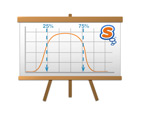Ready to see how awesome Shmoop is and why everybody is talking about us?

SAT Average Score
Why is Knowing the Average Score Important?
Because...that's the score the test writers are hoping most test-takers—including you—will earn!
For those of you not familiar with bells, the bell curve (See? We promised you there would be more later) is a graphical way of looking at score distribution. The flatter the bell curve, the wider the range in scores. If everybody who took the SAT scored between a 1740 and a 1750, the bell curve wouldn't really look like a bell at all. People would have to start calling it the doesn't-actually-resemble-a-bell curve, and that just doesn't have the same ring to it. Pun totally intended.

If the ladies and gents who created this test had asked questions so hard that even Einstein would have flunked, there would be no "dispersion" among takers. That is, we wouldn't get to see who had game and who didn't. That result would be of no use to colleges, and all that SAT sweat would have been shed for naught. You'd get the same result if the questions were so easy that everyone got a perfect score. Well, there would probably be less sweat.
Still, the goal of this test is to separate intellectual wheat from chaff, and the test creators are hoping that scores will follow a "normal" dispersion pattern. "Normal" does not refer to the bell curve's social habits; rather, it means that test scores demonstrate a fairly wide range: lots of scores in the big, fat middle and only a very small handful of scores on either side.
The test writers want most students to score in the 500s. Think about what a score of 500 means, though. It means that the gang who wrote the test wants a lot of students to get a lot of answers correct. Translation: Lots of easy questions.
On the other hand, to protect the upper echelons of 2200s and better, the test makers make some of the questions crazy-hard so that only Junior Bobby Fischers and Madames de Stael have a shot at getting 800s. The context here is the key point..
By knowing which questions the writers want you to miss, you can either
- Skip 'em like you were Russell Byars, or…
- Think like the test writers, and avoid the "sexy" answer choices. Those are answers with alluring-yet-dangerous choices that seductively call to the unsuspecting student, like Sirens in some mythical Odyssey. If you are not prepared to resist these pitfalls, you run the risk of being tempted, crashing your ship on the rocks, and being forced to spend the rest of your days hanging with Davy Jones in his mollusk- and conch-infested deep-sea digs.